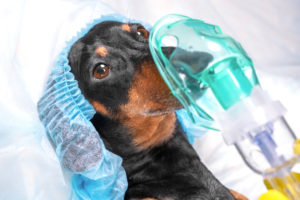Allergies in Pets: How They Manifest and How to Treat Them
Just like people, dogs and cats can be sensitive to various kinds of allergens – both food and environmental. The most common signs of an allergic reaction in your pet can include scratching, biting/chewing, or licking of their body. In cats, allergies can even lead to respiratory issues. When seeing a pet who is showing signs of an allergic reaction, we first try to find the source or cause of the reaction. There are three different sources of allergens that can harm our pets: allergens in the air, in food, and in fleas.
Treating allergies:
Fleas are generally the easiest of these allergens to treat. Some dogs and cats have what is called flea allergic dermatitis. This means that while they will get a small localized reaction from where a flea bites them, they will also have a larger systemic reaction which causes them to itch all over their bodies. For these pets, we simply need to get the dog or cat started on an adequate flea control medicine and the problem should resolve.
For ingested and environmental (also called atopic) allergies however, determining the cause and proper treatment of the allergic reaction can be a much more difficult proposition. Although environmental allergies are much more common than food allergies in pets, we almost always target food allergies first for two reasons. First, although food allergies are less common, they are much easier to control. If your dog is allergic to chicken, you can easily remove that from their diet whereas if your dog is allergic to oak pollen, you aren’t going to have much luck getting pollen out of the air. The other reason for looking at food allergies first has to do with something called the “allergy threshold”. One way to understand the allergy threshold is to think of a tea kettle being heated to make boiling water. Over time, as more and more heat gets added, the water in a tea kettle will simmer but the whistle won’t sound until the water is at a full boil. The point at which the kettle starts to whistle is analogous to an animal reaching its allergy threshold.
Allergies have a cumulative effect, meaning that each new allergen a pet is exposed to adds more stress on their body’s immune system. Just like the tea kettle, a pet will not become symptomatic until the “accumulated” allergens in their body exceed a certain threshold. What this means is that you and your veterinarian may be able to alleviate your pet’s allergies by simply removing a small portion of the total allergens to which they are exposed. For example, if 80% of a dog’s allergen exposure comes from pollen in the environment (something we can’t control for) while only 20% comes from the food he’s eating, removing that small amount of food allergens may be enough to keep the pet below the allergy threshold. So, even though food allergies statistically make up a much smaller proportion of pet allergens, we still go after them first in the hopes that, by eliminating the portion of allergens which are easily controlled, we may be able to get a pet beneath her allergy threshold.
If we do not see an improvement in a pet’s signs after changing their diet, we may then try treating the allergies symptomatically by administering a drug or supplement that lowers their immune response to allergens. This is akin to a human taking an antihistamine when they begin to feel their allergies acting up; dogs and cats can also be placed on antihistamines. There are also nutritional supplements such as fish oil, Duralactin – a natural anti-inflammatory, and products such as Canine Dermal Support which may decrease itching and scratching in your pet. You should always consult your veterinarian before trying these or any other over-the-counter treatments.
For more acute cases that do not respond to the above treatments, we might prescribe a corticosteroid. These medications act as powerful anti-inflammatories but come with the possibility of severe side effects, especially when given long term. Because of this, steroids are not the first line of defense against allergies and are generally not recommended to be given over long periods of time.
Allergy Testing and Allergy Shots: How They Can Help Your Animal
When a dog or cat has reached the point where we want to consider using steroids, it is often prudent to also consider allergy testing. Allergy tests can be done to detect either food or environmental allergies. As discussed earlier, we will usually target food allergies first simply because they are much easier to treat. For food allergies we recommend a test called Nutriscan which uses saliva to test for food sensitivities. After the lab analyzes these results, we get back a list of food ingredients that are allergens for your pet. Ideally, there is something on this list that can easily be removed from their diet.
Environmental allergy testing is the next option and tests for allergens that could be airborne. This type of test can either be done using blood or through a technique called intradermal testing, which means pricking their skin with different allergens to see how the pet reacts. Research doesn’t point to one test being better than the other as both yield accurate results. Since we cannot usually prevent a pet’s exposure to environmental allergies, we often begin an allergy desensitization protocol. Once we know what a dog or cat is allergic to, we can start them on a regimen of allergy shots or oral drops. These shots or drops work by slowly exposing an animal to small amounts of allergens to desensitize their immune systems over time. At best, this process takes months to see results, so this process requires some patience. While many pets will show improvement, some will not. Unfortunately, allergies are rarely things you are going to fix completely and are usually a lifelong affair. In these cases, steroids may be the best option.
If you are wondering why we don’t always do allergy testing right away, the answer is that it is fairly expensive and takes a while to yield positive results. It usually makes sense to begin with more affordable avenues of treatment that provide faster relief. When there isn’t a quick and easy fix, allergy shots and/or steroids or even immunosuppressants are usually the next best steps.
If you think your pet is experiencing allergies, explore and discuss the pros and cons of all possible treatment modalities with your veterinarian. It can be a long process but getting your pet relief is definitely a labor of love.
Did you like this article? make sure to checkout our blog on : 8 Common Toxins That Don’t Get Mentioned Enough




